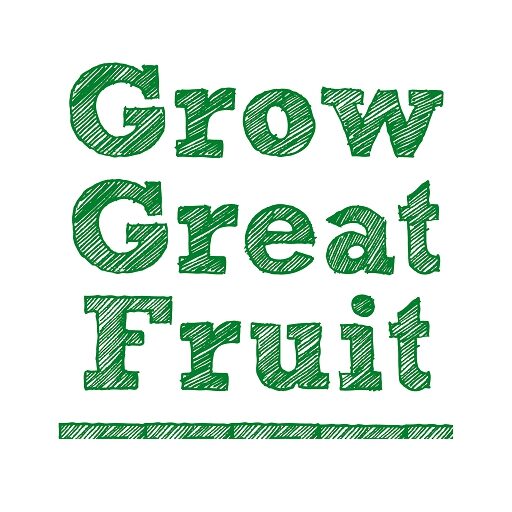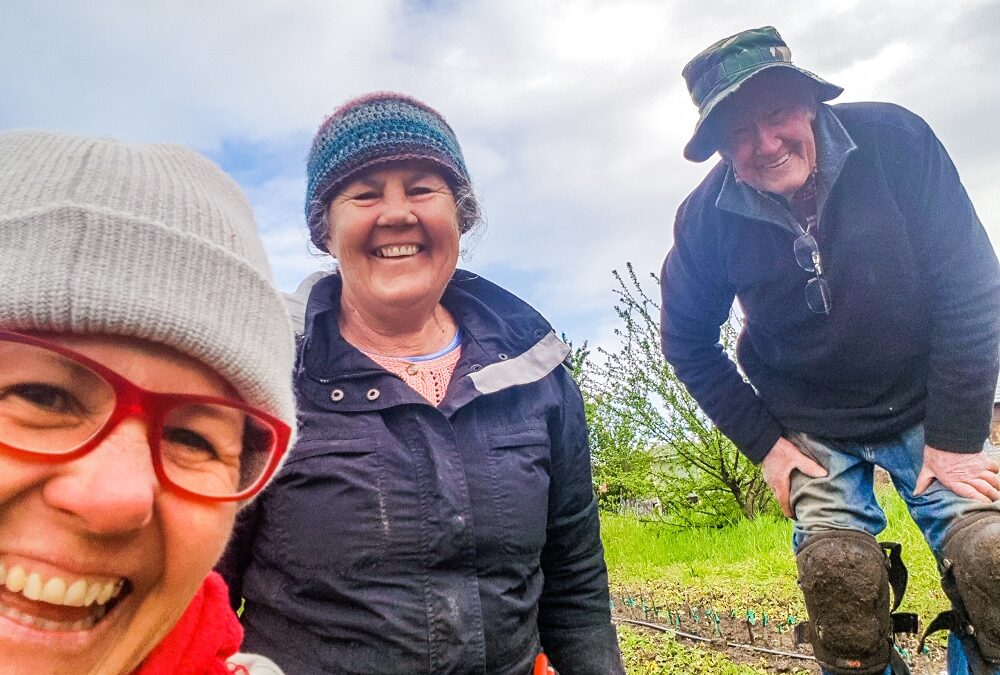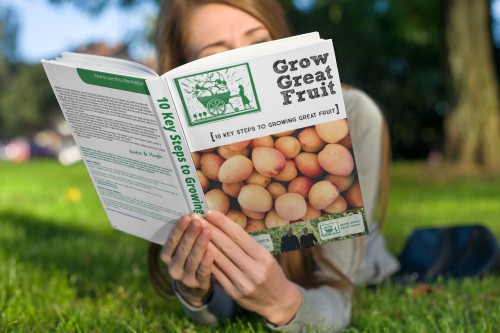If you want to buy fruit trees, you’re in the right place! As well as teaching fruit growing, we also grow and sell fruit trees from April to June each year. See the full list of trees and place your order here.
The trees are grown in the lush soil on the slopes of Leanganook (Mount Alexander), and are grown using organic practices. We were certified organic until 2025, when we decided to replace external certification with our own system.
The team includes Katie, her sister Liz Carr, and our esteemed leader and mentor, Merv Carr (who is also Katie and Liz’s dad). Together, we’re one of the enterprises that make up the Harcourt Organic Farming Co-op.
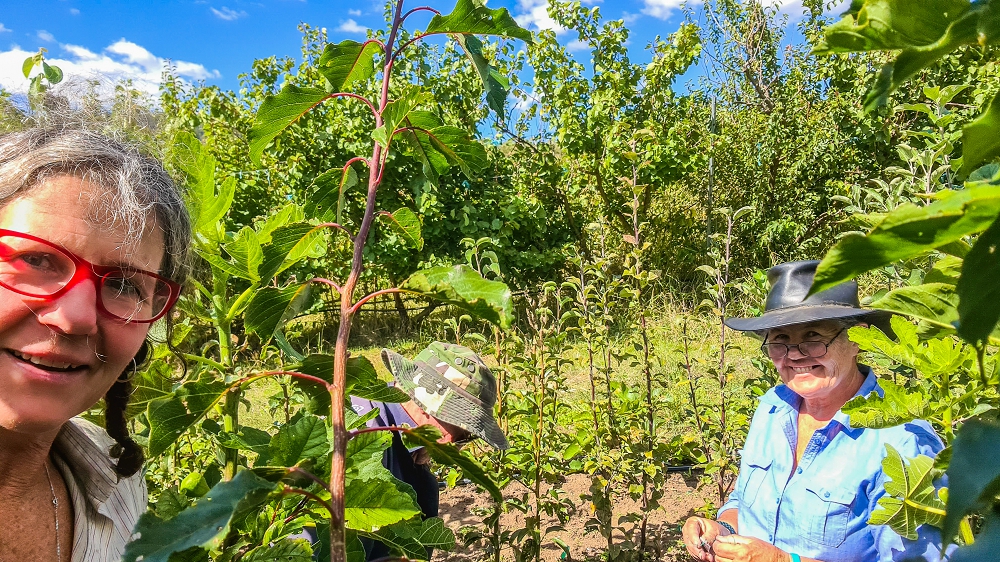
How to buy fruit trees
We sell trees bare-rooted in the winter months. You can pre-order the trees between April and June via the Open Food Network (OFN).
When you visit the OFN, there are a few things you’ll notice.
Finding the right fruit tree
- Tree type: You’ll see that the trees are listed alphabetically, e.g., Apricot, Apple, etc.
- Varieties: Within each type of tree, the varieties are also listed alphabetically.
- Search bar: Use this to search for the type of tree you’re looking for (e.g., citrus), or variety (e.g., Pink Lady). You can also search for characteristics (e.g., cider or clingstone).
- More information: When you click on the name of the tree, it will open up a box that has info about the fruit, pollination, and harvest to help you choose the tree that will suit you best.
Ordering trees
Trees need to be ordered by June 30, and then you can pick them up at the firm on the first two weekends of July. The trees are not available before that date for a very simple reason – they’re not harvested until just before they’re sold.
We don’t offer delivery, but only pick-up from our farm. That’s partly because the trees are grown in this climate to suit this climate (which extends to anywhere in Victoria or southern NSW).
If you can’t get to central Vic to pick up your trees, we urge you to buy your fruit trees from a local nursery or check out one of the excellent nurseries you can find online that offer deliveries.
If you’d like to order trees but can’t make it to the pick-up days, please get in touch. We’d prefer that you come on the nominated weekends (or get someone else to collect your trees) because the sooner the trees get in the ground at your place the better. But if necessary we can hang on to your trees for a little while and arrange a pick-up time that suits us both.
How we grow the trees in our nursery
We grow all our trees from scratch here on the farm.
First, we save seed from the fruit grown here on the farm and use it to grow as many of our own rootstocks as possible. Some rootstocks are grown from cuttings, also harvested on the farm. Occasionally, we buy specialty seed or rootstocks that we can’t grow ourselves.
Then we do all our own grafting, using scion wood from the fruit trees in the nursery and orchards here on the farm.
More than 140 varieties are growing here—including many heritage varieties—which allows us to offer a large range.
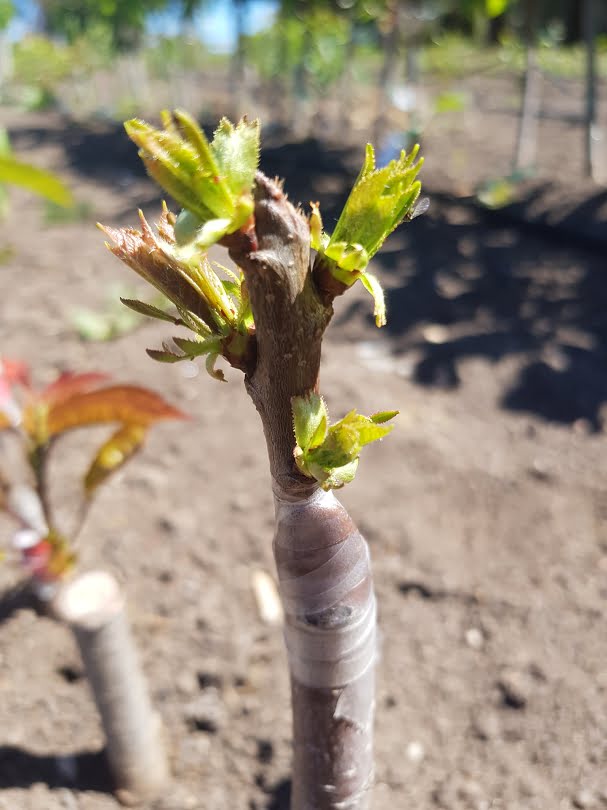
About the trees
We specialise in heritage and hard-to-find varieties and are constantly adding to our collection. Here’s what our labelling means:
Small – less than 40cm tall
Standard – between 40 cm and about 1.5m (this can vary). Some trees may have some branching, some may be single stems (whips)
Advanced – these trees are usually more than 1m tall, and have enough branches to make a vase shape. This means they won’t need establishment pruning when you plant them, and they’re likely to produce fruit sooner than Standard trees.
Dwarf – only dwarf apples available. These trees are grown on semi-dwarfing rootstock (MM102) and should grow to approximately 50% of a standard tree.
Multi-graft – these trees have more than one variety of the same type of fruit, e.g., cherries or apples.
Fruit-salad trees – these have more than one type of fruit, e.g., a peach and a nectarine, or a plum and an apricot.
We make every effort to supply the trees you’ve ordered. Occasionally, through misadventure when harvesting the trees, or a simple case of miscounting, we get it wrong. In that case, we’ll either offer you an alternative tree or give you a full refund.
Other resources to help you choose the right tree
No matter where you buy your fruit trees, choosing the right ones to suit your family is a big topic!
We have lots of other resources to help in our Online Short Course Library. The three most recommended to get you started are:
Fruit Tree Pollination Guide
This handy guide lists pollination partners for hundreds of common (and uncommon) fruit trees, giving you the information you need to select the right trees for a fruitful backyard orchard.
Pollination partners for fruit trees are one of those things that most gardeners have heard of, but few really understand! Knowing if your tree needs pollination can be a complete mystery. It’s one of the ‘hidden’ reasons for fruit trees failing to produce fruit.
Many fruit trees need a compatible partner nearby to help them set fruit — it’s nature’s version of matchmaking. In this guide, we demystify how pollination works, explain which trees need partners (and which don’t), and help you choose the best pollination companions for a thriving, productive home orchard.
The guide includes:
- Definitions of common pollination-related terms;
- Things that can affect pollination;
- Stages of flowering;
- Order of blossom times for deciduous fruits;
- Pollination needs for different types of fruit trees;
- Comprehensive lists of pollination partners for most common varieties.
👉🏼 Download Fruit Tree Pollination Guide here.
Comprehensive Guide to Fruit Ripening Dates
This is one of our most useful resources! It includes the ripening dates (and order) of hundreds of common fruit trees to guide your tree selection. This guide makes it possible to choose the right trees for almost year-round fruit harvests while avoiding gluts and fruit ripening at inconvenient times.
The actual date that a variety ripens for harvest can vary wildly. It’s affected mainly by your climate, but also microclimate and the conditions of each season. The beauty (and usefulness) of this guide lies in the fact that, regardless of where you live, the order of ripening of different varieties stays about the same.
This guide includes ripening charts for:
- More than 200 apple varieties
- More than 60 apricots
- Ripening sequence for blueberries, raspberries, and blackberries
- 75+ cherry varieties
- Over 50 varieties of citrus, including lemons, oranges, cumquats, mandarins, grapefruit, and tangelos
- Almost 200 varieties of peach and nectarine
- 200 varieties of pear and quince
- Almost 150 varieties of plum
- Harvest sequence for subtropicals, including avocados, custard apples, feijoas, figs, mangoes, and mulberries.
This is just a selection of available varieties—there are many thousands of fruit tree varieties available in the world. In this guide, we’ve focused on trees that are likely to be available for you to buy. Wherever possible, we’ve included trees from many of the well-known nurseries around Australia, and in some cases overseas as well.
👉🏼 Download Guide to Fruit Ripening Dates here
Home Orchard Design: Plan your fruit tree plantings for long term success.
With good planning and design, you can have fresh deciduous fruit from late spring to early winter in a temperate climate. This guide is all about learning about your microclimates to help you choose the right fruit trees for the right place, with the right protection.
👉🏼 Download Home Orchard Design Short Course here.


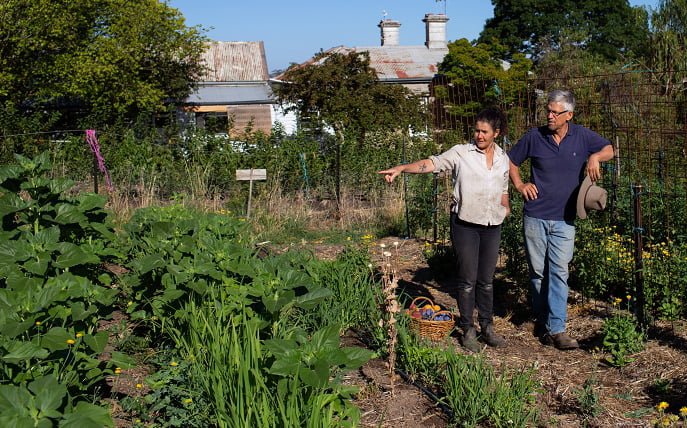
Any enquiries? Shoot us an email.
Thanks for buying your fruit trees from us. We appreciate it!
Cheers,
Katie, Liz, and Merv
